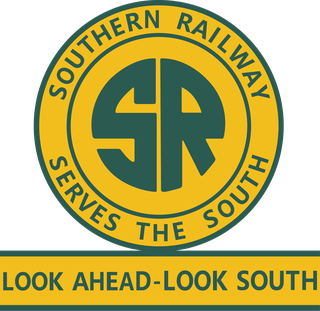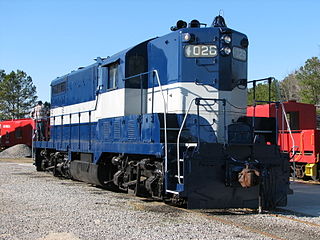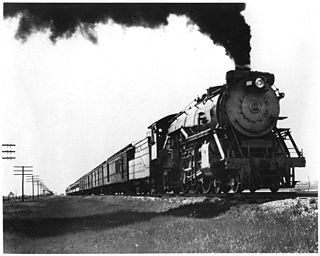Related Research Articles

Florence is a city in Williamson County, Texas, United States. The population was 1,171 at the 2020 census. Since 2000, the territorial limits of Florence have grown by 8%. Florence is located approximately 13 miles (21 km) north from Georgetown and 40 miles (64 km) north of Austin in northwestern Williamson County. Florence is part of the Greater Austin metropolitan area.
Bartlett is a city in Bell and Williamson counties in the U.S. state of Texas. The population was 1,633 at the 2020 census.

The Union Pacific Railroad is a Class I freight-hauling railroad that operates 8,300 locomotives over 32,200 miles (51,800 km) routes in 23 U.S. states west of Chicago and New Orleans. Union Pacific is the second largest railroad in the United States after BNSF, with which it shares a duopoly on transcontinental freight rail lines in the Western, Midwestern and West South Central United States.

The New York Central Railroad was a railroad primarily operating in the Great Lakes and Mid-Atlantic regions of the United States. The railroad primarily connected greater New York and Boston in the east with Chicago and St. Louis in the Midwest, along with the intermediate cities of Albany, Buffalo, Cleveland, Cincinnati, Detroit, Rochester and Syracuse. New York Central was headquartered in New York City's New York Central Building, adjacent to its largest station, Grand Central Terminal.

Jarrell is a city in Williamson County, Texas, United States. The total population is 1,753 according to the 2020 census.

The Chicago, Burlington and Quincy Railroad was a railroad that operated in the Midwestern United States. Commonly referred to as the Burlington Route, the Burlington, or as the Q, it operated extensive trackage in the states of Colorado, Illinois, Iowa, Missouri, Nebraska, Wisconsin, Wyoming, and also in Texas through subsidiaries Colorado and Southern Railway, Fort Worth and Denver Railway, and Burlington-Rock Island Railroad. Its primary connections included Chicago, Minneapolis–Saint Paul, St. Louis, Kansas City, and Denver. Because of this extensive trackage in the midwest and mountain states, the railroad used the advertising slogans "Everywhere West", "Way of the Zephyrs", and "The Way West".

The Chicago Great Western Railway was a Class I railroad that linked Chicago, Minneapolis, Omaha, and Kansas City. It was founded by Alpheus Beede Stickney in 1885 as a regional line between St. Paul and the Iowa state line called the Minnesota and Northwestern Railroad. Through mergers and new construction, the railroad, named Chicago Great Western after 1892, quickly became a multi-state carrier. One of the last Class I railroads to be built, it competed against several other more well-established railroads in the same territory, and developed a corporate culture of innovation and efficiency to survive.

The Southern Railway was a class 1 railroad based in the Southern United States between 1894 and 1982, when it merged with the Norfolk and Western Railway (N&W) to form the Norfolk Southern Railway. The railroad was the product of nearly 150 predecessor lines that were combined, reorganized and recombined beginning in the 1830s, formally becoming the Southern Railway in 1894.

The Virginia and Truckee Railroad is a privately owned heritage railroad, headquartered in Virginia City, Nevada. Its private and publicly owned route is 14 miles (23 km) long. When first constructed in the 19th century, it was a commercial freight railroad which was originally built to serve the Comstock Lode mining communities of northwestern Nevada.

The St. Louis–San Francisco Railway, commonly known as the "Frisco", was a railroad that operated in the Midwest and South Central United States from 1876 to November 21, 1980. At the end of 1970, it operated 4,547 miles (7,318 km) of road on 6,574 miles (10,580 km) of track, not including subsidiaries Quanah, Acme and Pacific Railway and the Alabama, Tennessee and Northern Railroad; that year, it reported 12,795 million ton-miles of revenue freight and no passengers. It was purchased and absorbed into the Burlington Northern Railroad in 1980. Despite its name, it never came close to San Francisco.

The St. Louis Southwestern Railway Company, known by its nickname of "The Cotton Belt Route" or simply "Cotton Belt", is a former Class I railroad that operated between St. Louis, Missouri, and various points in the U.S. states of Arkansas, Tennessee, Louisiana, and Texas from 1891 to 1980, when the system added the Rock Island's Golden State Route and operations in Kansas, Oklahoma, and New Mexico. The Cotton Belt operated as a Southern Pacific subsidiary from 1932 until 1992, when its operation was assumed by Southern Pacific Transportation Company.

The Georgia Railroad and Banking Company also seen as "GARR", was a historic railroad and banking company that operated in the U.S. state of Georgia. In 1967 it reported 833 million revenue-ton-miles of freight and 3 million passenger-miles; at the end of the year it operated 331 miles (533 km) of road and 510 miles (820 km) of track.
The Lake Superior and Ishpeming Railroad, is a U.S. railroad offering service from Marquette, Michigan, to nearby locations in Michigan's Upper Peninsula. It began operations in 1896. The LS&I continues to operate as an independent railroad from its headquarters in Marquette.

The Spokane International Railroad was a short line railroad between Spokane, Washington, and the Canadian Pacific Railway (CP) at Kingsgate, British Columbia. The line became an important one for the CP with its connections to the Union Pacific Railroad and Portland, Oregon.

The Fort Worth and Denver Railway, nicknamed "the Denver Road," was a class I American railroad company that operated in the northern part of Texas from 1881 to 1982, and had a profound influence on the early settlement and economic development of the region.
The 5-mile (8.0 km) Reader Railroad was a tourist-only railroad operating in Reader, Arkansas from 1973 to 1991. As a 23-mile (37 km) common carrier prior to May 1973, it was the last all steam locomotive-powered, mixed train railroad operating in North America. It operated trackage in Ouachita County and Nevada County, Arkansas. The five mile tourist railroad operated until 1991, when it could not meet the new federal safety regulations.
Schwertner is an unincorporated community in Williamson County, Texas, United States. It is approximately 28 miles north-northeast of Round Rock. Schwertner has a post office, with the ZIP code 76573.

The Mississippi Delta Railroad is a shortline railroad company operating from Swan Lake to Jonestown, Mississippi, a distance of 60 miles (97 km); the railroad interchanges with the Canadian National at Swan Lake. Currently the railroad is owned by Coahoma County and was a former subsidiary of Gulf and Ohio Railways shortline group. The current operator is Rock Island Rail.
The Stephenville North & South Texas Railway (SN&ST) was incorporated in Texas on February 4, 1907, by Stephenville and Hamilton business interests. Its original standard gauge 43-mile line was built between Stephenville and Hamilton and completed in late 1907. The first train operated between Stephenville and Hamilton on Christmas Day 1907. Regular service began in January 1908. Four apparently identical wooden depots of a standard design were built at Hamilton, Carlton, Spurlin, and Alexander. The SN&ST shared a Union Station with its original primary railroad connection, the long-established Fort Worth & Rio Grande Railroad at Stephenville.

Southern Pacific No. 1744 is a preserved American class "M-6" 2-6-0 "Mogul" type steam locomotive built by the Baldwin Locomotive Works for the Southern Pacific Railroad in November 1901. Originally equipped with Vauclain compound cylinders, it was rebuilt with conventional cylinders in 1912. It operated for many years out of Oakland, California on the Southern Pacific's Western Division and in California's Central Valley where the locomotive and its classmates were fondly called “Valley Mallets” by their crews. The locomotive was made famous in later years by pulling some of the last steam excursions on the SP alongside other steam locomotives, including 4-8-4 4460. In 1959, No. 1744 was donated to the Sons of Utah Pioneers in Corinne, Utah where it remained on static display, until 1980. That year, it was restored by New London Railroad and Village Incorporated to operate on the Heber Valley Railroad in Heber City for the rest of the decade.
References
- 1 2 3 4 "The Bartlett-Florence Railroad later named the Bartlett Western Railroad". Williamson County Texas History. Retrieved November 29, 2021.
- 1 2 3 4 5 6 7 8 9 "Bartlett Western Railway". Chris Cravens, Texas State Historical Association. Retrieved November 29, 2021.
- 1 2 3 4 5 6 "The Four Gospels Railroad". Myra H. Mcilvain. Retrieved November 29, 2021.
- ↑ "Throwback Thursday: Loss of Florence Landmark Prompts Memories of Cotton Gin Operations". The Independent, Liberty Hill, November 6, 2017. Retrieved November 30, 2021.
- ↑ "Bond Issue for Construction of Road". Railway World, July 15, 1910. 1910. Retrieved November 30, 2021.
- 1 2 "Corn Hill, Texas". TexasEscapes.com. Retrieved November 30, 2021.
- 1 2 "Jarrell, Texas". TexasEscapes.com. Retrieved November 30, 2021.
- ↑ "Bartlett Western 2-6-0 "Mogul" Locomotives in the USA". SteamLocomotives.com. Retrieved November 29, 2021.
- 1 2 3 4 5 6 7 8 9 10 "The Old Bartlett Western Railroad and Marie Cronin". Clay Coppedge, TexasEscapes.com. Retrieved November 29, 2021.
- 1 2 "Article, All Aboard, October 1986" (PDF). The Frisco Railroad Museum. Retrieved November 29, 2021.